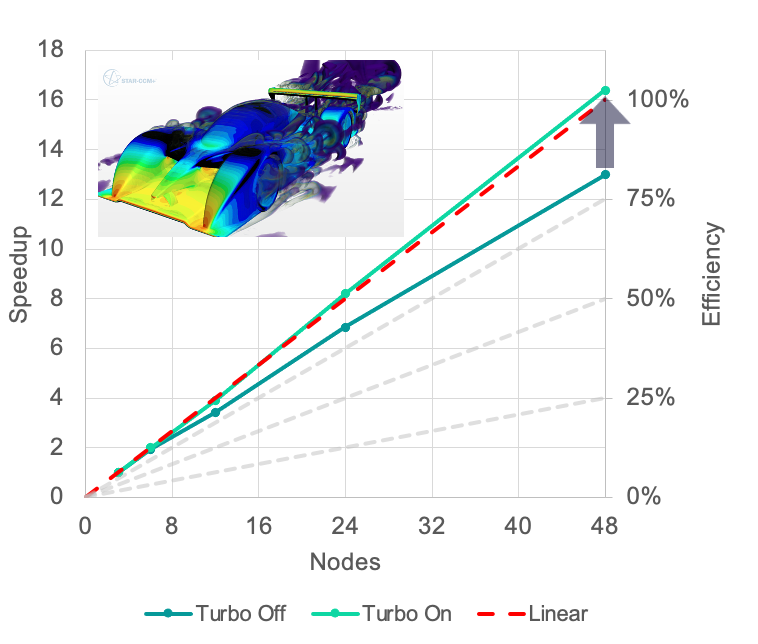In today’s fast-paced product development landscape, the demand for simulation-led design is higher than ever. Engineers are tackling increasingly complex challenges—multiphysics problems, intricate geometries, and tight timelines. At TotalSim, we leverage cutting-edge high-performance computing (HPC) hardware to make Simcenter STAR-CCM+ simulations faster, more accurate, and more scalable, helping our clients make smarter decisions, quicker.
Why HPC Matters for STAR-CCM+ Workflows
Simcenter STAR-CCM+ is a powerful multiphysics simulation platform. But to extract its full potential—especially for large-scale design space exploration, steady and transient CFD, or multi-physics problems—you need robust hardware. STAR-CCM+ is built to scale across thousands of cores, enabling:
- High-fidelity results from large, realistic models
- Faster simulation turnaround to meet tight deadlines
- Concurrent design studies for optimization and innovation
- Support for advanced features like GPU acceleration, mixed precision solvers, and more
The Hardware That Makes It Happen
At TotalSim, our simulation hardware stack is carefully selected and continuously optimized for STAR-CCM+. Here’s how we think about the building blocks of HPC for CFD:

CPUs: Core Count Meets Cache
Modern CPU architectures like AMD EPYC and Intel Xeon continue to push boundaries on core count, memory channels, and cache size. For CFD, more cores generally mean faster turnaround—but only if bandwidth and cache scale with it. TotalSim uses high-core-count CPUs (often dual-socket) with tuned BIOS settings, disabled hyperthreading (when needed), and Turbo Boost to maximize performance.
Tip: In many STAR-CCM+ benchmarks, AMD’s EPYC “Milan” and “Genoa” CPUs offer superior price/performance due to large L3 cache and memory bandwidth.
Memory: The Hidden Bottleneck
STAR-CCM+ is a memory-bound application. That means bandwidth and configuration matter as much as total capacity. We follow strict memory balancing rules and always use high-speed ECC DDR5 RAM to ensure maximum throughput. For large models, our rule of thumb is over 4GB per core—essential for both meshing and solving.
Storage: Speed and Parallelism
CFD workloads can generate significant I/O, especially during transient runs. TotalSim utilizes fast SSD arrays and parallel file systems like Lustre or GPFS on larger clusters. This ensures that simulation data can be written and retrieved without becoming a bottleneck—critical when running on 100+ cores.
Interconnects: Low Latency, High Bandwidth
For clusters, we rely on InfiniBand interconnects to maintain performance across nodes. CFD simulations are communication-intensive, and bandwidth/latency tradeoffs matter. Our systems are designed to minimize data hops and maximize throughput.
Fun fact: A poorly designed interconnect can reduce performance by over 50% on clusters larger than 8 nodes.
GPUs: Accelerating Simulation Throughput
GPU acceleration in STAR-CCM+ has come a long way. We now routinely run GPU-native simulations on NVIDIA A100, H100, and even workstation-class RTX 6000 Ada GPUs for supported physics models. These cards often outperform 100+ CPU cores, and we use them to dramatically reduce turnaround for large, steady-state simulations or LES cases.
One RTX 6000 Ada can rival the performance of 200+ AMD EPYC cores—at a fraction of the power cost.
Cloud: Instant Scalability
When clients need results fast, or when physical hardware is at capacity, we use Siemens’ cloud-optimized STAR-CCM+ environment. On-demand HPC clusters with optimized CPUs/GPUs mean we can burst to thousands of cores for rapid throughput, without the capital investment.
Our Take: Tailored Hardware = Better Results
Choosing the right hardware isn’t just about buying the most powerful processors. It’s about balance: matching CPU power with memory, storage, and interconnect performance to support your unique simulation needs. At TotalSim, we’ve spent years fine-tuning our systems for STAR-CCM+, so our clients don’t have to worry about what’s under the hood—they just get fast, reliable results.
Whether you’re running a few million cells or several billion, optimizing your simulation hardware stack is key to unlocking STAR-CCM+’s full potential—and TotalSim is here to help.
